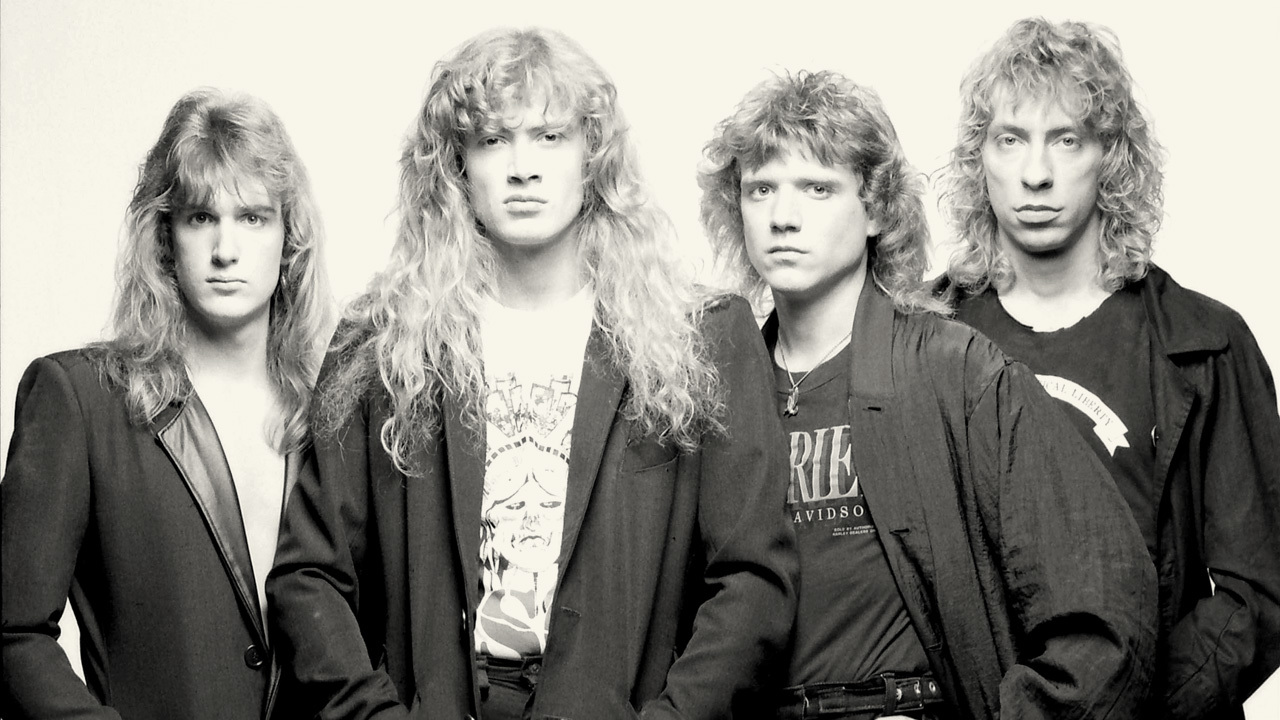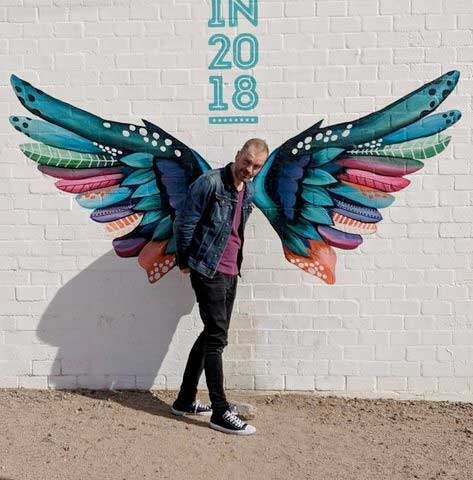The night Megadeth launched their second album started out as a celebration and ended up in a fight. It was late summer in 1986, and the band put together three years earlier by firebrand ex-Metallica guitarist Dave Mustaine were about to announce their arrival into thrash metal’s big league.
Their new label, Capitol, had rented out the Fire Fly bar in Hollywood to unveil the album, a slice of venomous yet socially aware metal titled Peace Sells… But Who’s Buying?. A pair of limos had been hired out to get the band there – one for Mustaine and bassist/wingman Dave Ellefson and their girlfriends, the other for guitarist Chris Poland and drummer Gar Samuelson and their other halves.
The party itself went off without a hitch. The band drank and snorted their way through the evening as the album blasted out of the club’s speakers. The problems started when it was all over. The foursome’s girlfriends had already left, leaving the band members to share the remaining car.
“So the four of us pile into one of these limos,” Mustaine says today, “and almost right away we get into an argument. I end up kicking Chris Poland in the face. That kind of gives you an idea of what you would have seen back then.”
This was a typical night for Megadeth. With the mercurial Mustaine steering them, the LA band brought an element of explosive volatility to thrash. If Metallica were the scene’s party-loving kingpins, Slayer its cartoon Satanists and Anthrax its court jesters, then Megadeth were its feral delinquents. That they managed to make one of the defining albums of the thrash era in Peace Sells – and one of its most immortal songs in the classic title track – is some achievement. That they managed to do it without killing each other or themselves is nothing short of miraculous.
“Dave and I were in a position where there was no Plan B,” says Dave Ellefson. “There was no escape hatch. There was no: ‘If this doesn’t work we’ll go do that.’ That backs-against-the-wall commitment is what drove us to make Peace Sells.”
Mustaine puts it more bluntly: “There’s a lot of crazy shit that was going on back then. I’m grateful we’re still here.”
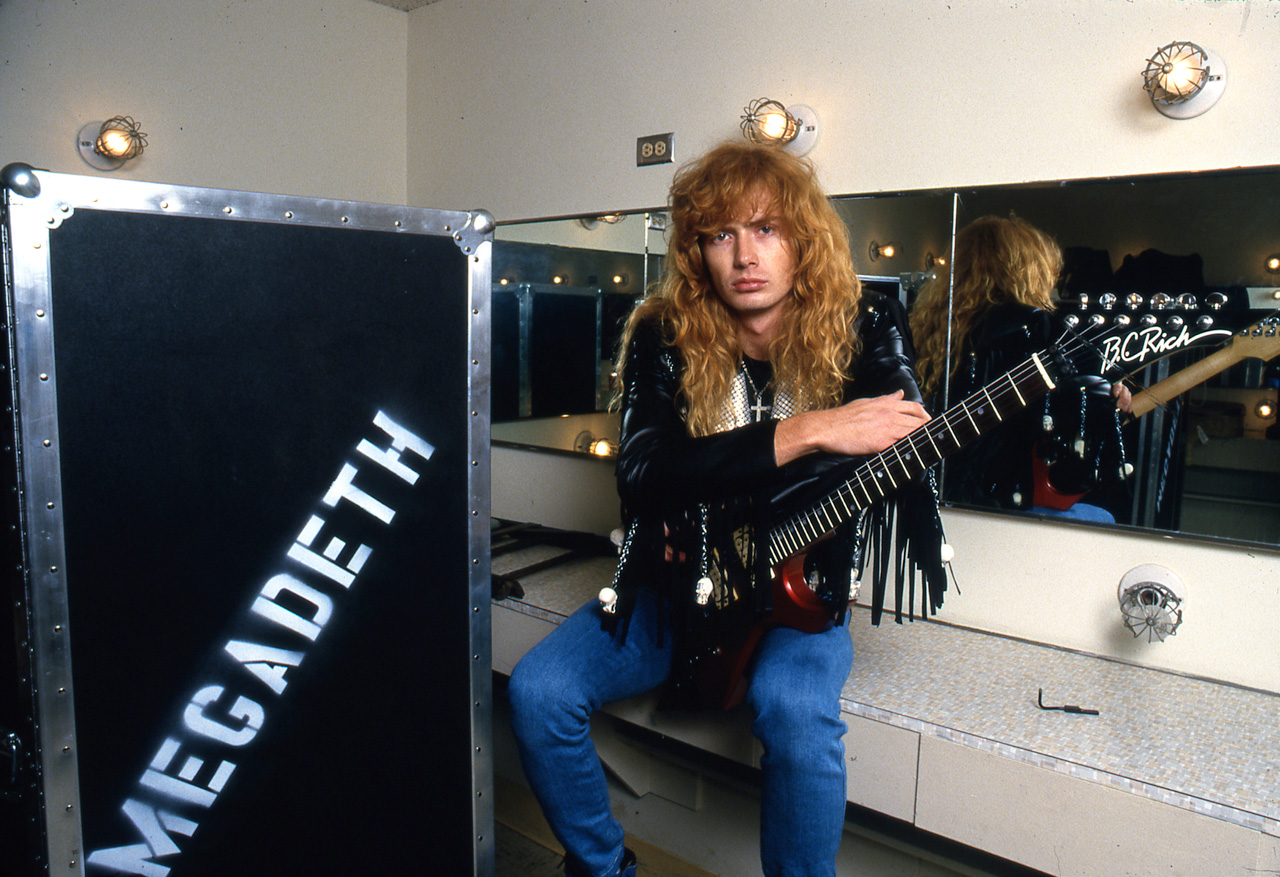
Dave Mustaine is one of rock’s great survivors. Rather than slink away from the spotlight after being booted out of an on-the-verge-of-fame Metallica because of one too many drunken arguments, he channelled his anger into a new band, Megadeth. He’s been the mouthpiece, driving force and backbone of the group ever since, through bitter rivalries, drug addiction and a seemingly endless churn of guitarists and drummers.
Today Mustaine is older but no less unpredictable. Alternately honest and cagey, passionate and dismissive, he’s like a wary cat: one stupid misstep and you know the claws will come out. It’s all part of the reputation: Dave Mustaine against the world. Or maybe it’s the world against Dave Mustaine.
“I never really felt like it was like that,” he says. “Although I’ve had a lot of people come up to me and say: ‘Why do people always pick on you all the time?’ And I just laugh. Because if you’ve got something that people want, they’re gonna try and take it from you. It’s the same in sports – if you’re successful, people go after you. Trash talking doesn’t affect me at all.”
It was this bullishness that got Megadeth off the ground in the first place. Their debut album, 1985’s Killing Is My Business… And Business If Good, balanced a sneering punk spirit with the sort of musicianly chops that even Metallica could only dream of. That album was recorded on a budget of $8,000, and it sounded like it. But for Dave Mustaine, money – or lack of it – was no object.
“One of the most charismatic qualities that I always liked about Dave was his ability to see the bigger goal,” says Ellefson, who co-founded Megadeth with Mustaine in 1983. “As bleak and broke and homeless as we were, he always had this optimism about him.”
He’s not exaggerating about the band’s circumstances at the time. Although Killing Is My Business had been well-received by the press and fans alike, thrash metal was a long way from being commercially rewarding. While Chris Poland had a girlfriend with money, and Gar Samuelson had a job working for guitar makers BC Rich, Mustaine and Ellefson were in perpetual motion, surfing from sofa to sofa, picking up girls at the clubs on Sunset Strip so they had a place to stay. Keeping an eye on how their debut album was doing was the last thing on their minds.
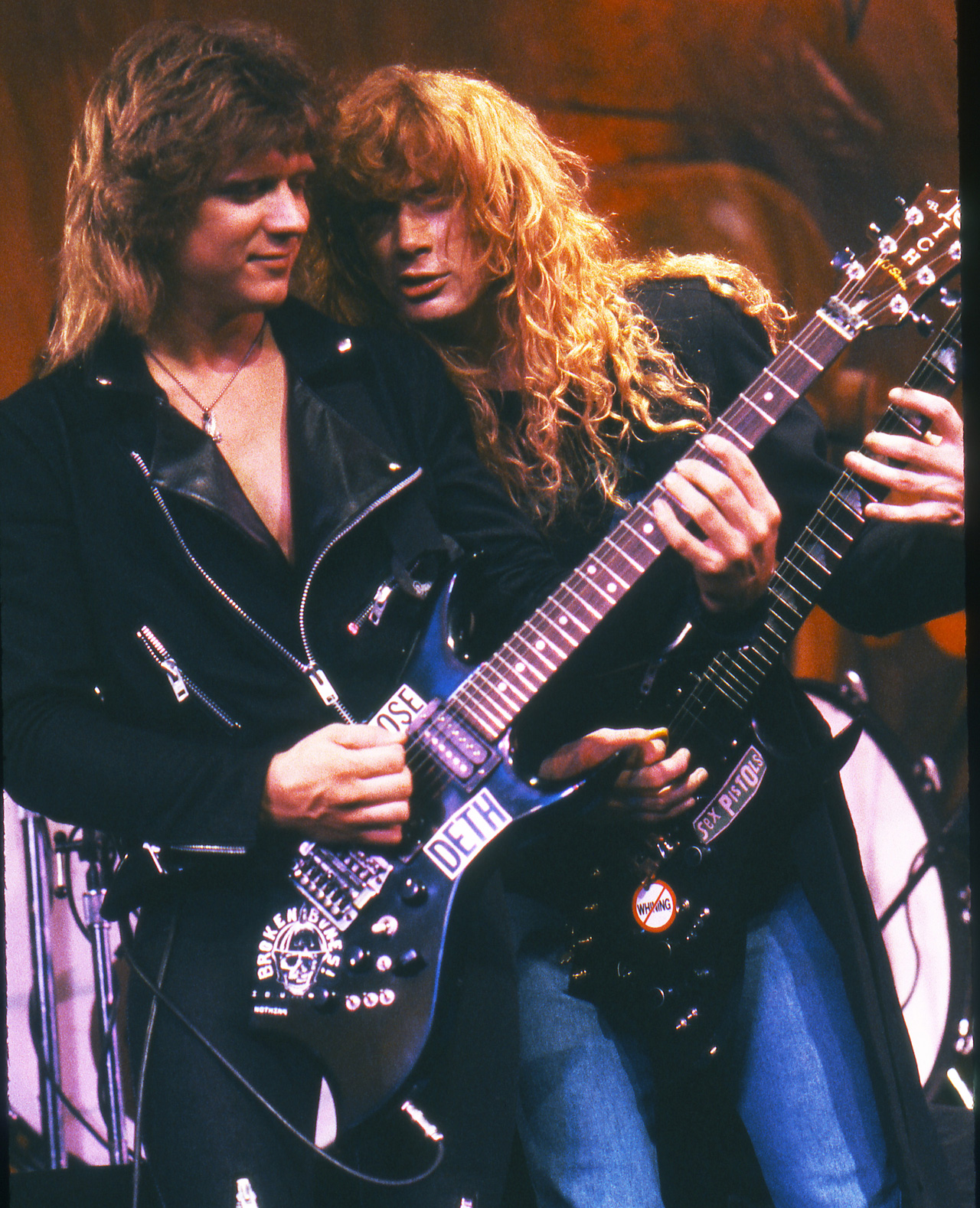
“We were scratching and clawing to find a place to sleep and food to eat, so we couldn’t appreciate how well Killing Is My Business was doing,” says Mustaine. “The threat of survival was more important than sitting back and saying: ‘Wow, let’s look at the charts,’ and shit like that.”
Things weren’t helped by their relationship with their label, Combat. Ellefson remembers being out on tour with Canadian thrashers Exciter and asking Combat for more money just so they could finish it. “They told us we should just go home and get jobs,” he says.
The label had underestimated Mustaine and Ellefson’s determination to succeed. The pair were keeping a close eye on the rest of the thrash metal pack – Anthrax, Slayer and Metallica. Especially Metallica. The accepted narrative is that every decision Dave Mustaine made was defined by his firing from that band.
“No, that’s not true,” he says now. “Maybe in the beginning there was quite a lot of merit in it. It was revenge for a little while, but then it was never really something I thought about constantly: ‘I gotta get back at those guys.’”
In any case, Mustaine and his bandmates had more to focus on: namely the music they were making and the drugs they were taking.
Chris Poland and Gar Samuelson were a pair of jazz-loving New Yorkers who had previously played in Mahavishnu-style fusion bands and had brought their own heroin habits to LA with them. Mustaine and Ellefson, who were no strangers to booze and coke, soon jumped on board that train.
“It was very hard,” says Ellefson. “Any money we should have saved for food or paying rent immediately went up our noses, or on cigarettes or burgers. Peace Sells… But Who’s Buying? was the heroin, cigarettes and hamburgers album.”
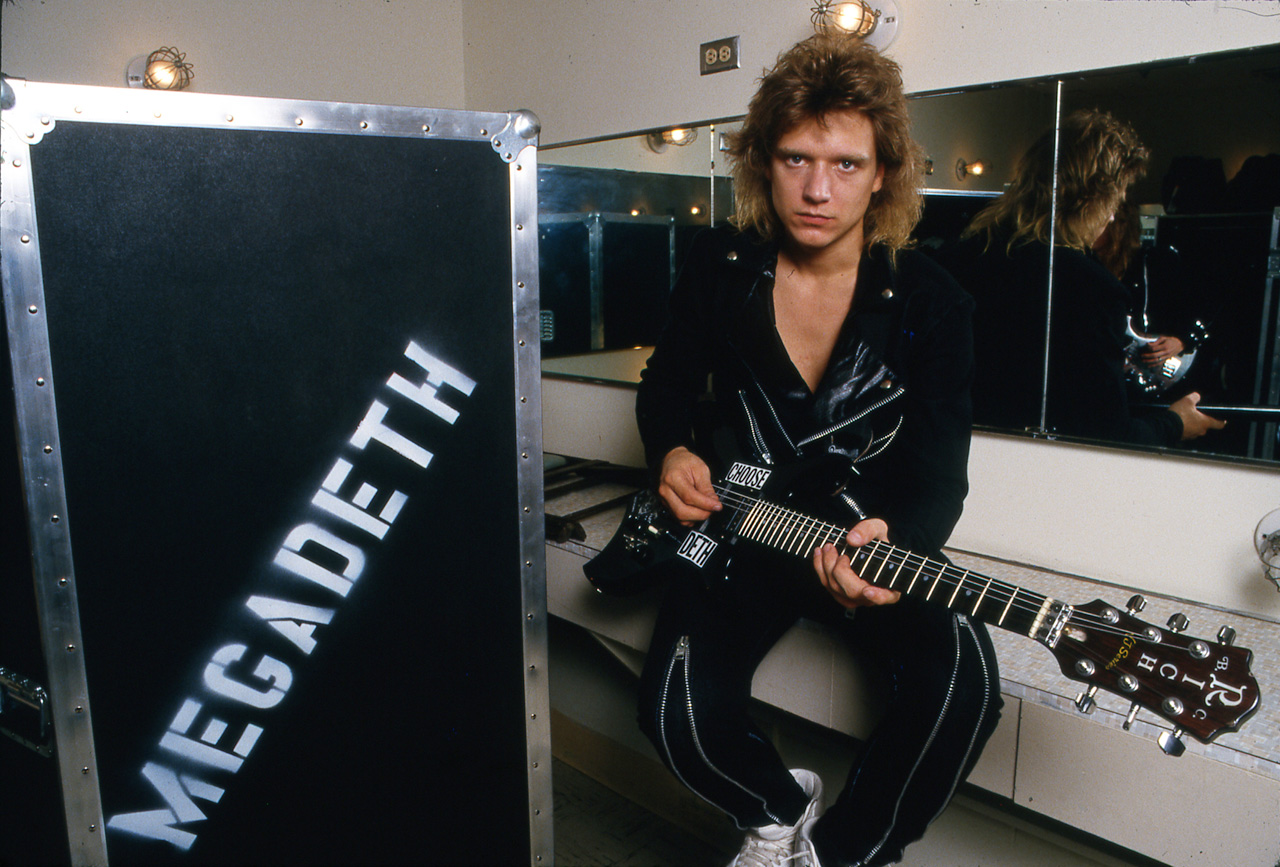
Heroin may have sunk its claws into Megadeth, but the fog wasn’t so thick that it completely clouded their ambition. The band moved into a dank rehearsal room in Vernon, an industrial area south of LA’s downtown. They’d kitted out the room with egg crates and built a loft so they could crash there.
“On any given day, either me or Dave was homeless,” says Ellefson. “And so it became a party place – we could invite girls down, we could hang out. It was the place to hang. But it was also a very lonely, dark, bleak existence if you ever had to stay there. You’d pass out hearing other bands rehearsing all night.”
Despite their living circumstances, there was a momentum to Megadeth as they entered Music Grinder Studio with producer Randy Burns in March 1986 to record Peace Sells. Their label stumped up $25,000 to make the album – triple the advance for Killing Is My Business. “It was like: ‘Wow, this is a real record deal,” Ellefson remembers. “We’ve got enough to make a good-sounding record. There’s even a couple of bucks to pay some bills and survive.’”
But that same streak of self-sabotage that had got Mustaine dismissed from Metallica was there in Megadeth. They knew what was riding on this album, but old habits die hard – and new ones were just as difficult to shake.
“There was a lot of debauchery in the studio,” says Mustaine. “A lot of tension. There were times when we would get there and one of the members wouldn’t have arrived because something was physically wrong and they had to do something in order to be physically right. So that was kind of a bitch. But we were all struggling with this terrible issue that we had, and in order to deal with it, things had to be just right every day. It was just such a pain in the ass having to deal with that. The music part was great. But getting everybody right so they felt okay was awful.”
It’s a mark of Mustaine’s drive that the songs that made up Peace Sells were already written long before Megadeth began recording it. Ellefson recalls the singer playing him one song, the jagged prison-break tale Devil’s Island, when they first met three years earlier. The pivotal title song appeared out of nowhere.
“We were up at [Killing Is My Business co-producer] Karat Faye’s house,” recalls Ellefson. “I had this BC Rich Eagle bass that we’d ripped the frets out of. I remember Dave picked the bass up and started playing what would become the Peace Sells bass line, just like that. That same day, we were driving over to Vernon to pick up Gar, and Dave looks over at me and said: ‘What do you think of Peace Sells But Who’s Buying?’ I was, like: ‘Wow, that’s cool.’ We got to rehearsal, and that song fell out on the rehearsal room floor in about two hours. That was not a typical groove for Megadeth. It almost felt too simple in a way.”
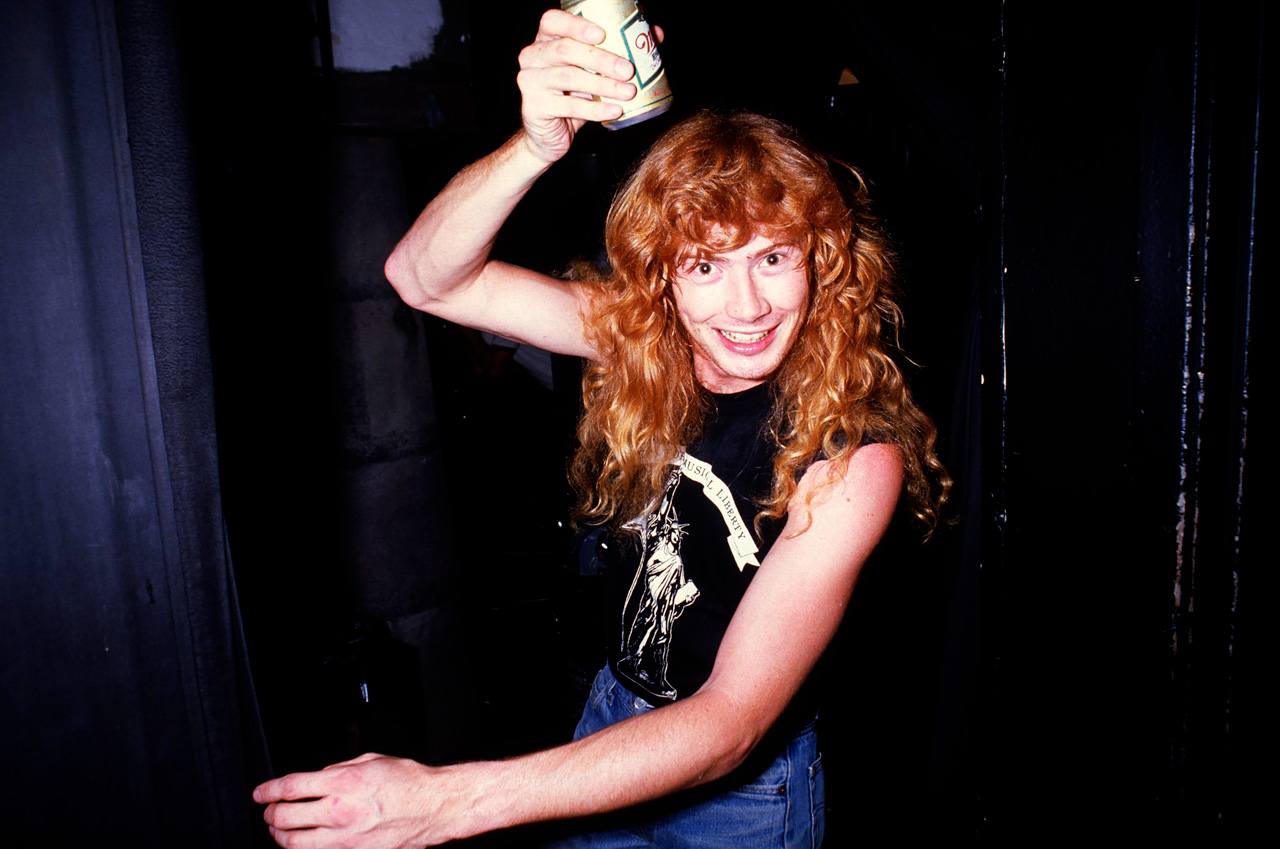
Peace Sells remains one of the most iconic tracks of the thrash era. With its instantly recognisable bass line and rolling groove, it set Megadeth apart from the thrash pack. Lyrically, too, its jaundiced view of government and religion dispensed with metal’s traditional swords-’n’-sorcery approach in favour of a more realistic world view. When Mustaine sang: ‘What do you mean, I don’t support your system? I go to court when I have to,’ he meant it. This was CNN as filtered through the eyes of a street punk.
“I’ve never been a fantasy metal writer,” he says now. “But as far as the punky stuff, that was the biggest part of me growing up when I first started playing. I loved the real heavy power chords, but I loved the snottiness of punk. I dug that whole punk rock way of life. That’s really how we were living, in squalor.”
There was a gritty reality to Megadeth that their thrash peers lacked. The vicious Wake Up Dead, the opening track on Peace Sells, was a tale of infidelity in which Mustaine played a man cheating on his partner with an illicit lover named Diana. Was there a real Diana?
“Yes,” he says. “There’s so many songs written about her. Wake Up Dead is about her, Trust is about her, Loved To Death is about her, Tornado Of Souls is about her. She was my fiancée. I was engaged to her for seven years. In California, if you’re with somebody for seven years, you’re automatically married by law. Not that she would have been a bad person to be married to, because she’s a great person. But if I’d have stayed in that relationship just a couple more months, that’s where I would have been.”
The album did occasionally stray into standard-issue heavy metal horror territory, though. Bad Omen was based on a 1972 supernatural novel by Thomas Tyron that Mustaine remembered reading at school, while The Conjuring is an occult ritual set to music, supposedly with a partial hex embedded in the lyrics (the band stopped playing the song in the 2000s because it clashed with the frontman’s Christian beliefs). Corniest of all is the serial-killer fantasy Good Mourning/Black Friday, although its tale of a ‘bloodthirsty demon stalking the streets’ has been undercut in recent years by fans posting memes featuring the song’s lyrics on Twitter on the US shopping day Black Friday.
There was also a curveball on the album in the shape of their cover of Willie Dixon’s blues classic I Ain’t Superstitious. “That was done primarily because Jeff Beck had done it,” says Mustaine. “Jeff Beck was a huge influence on Poland and Samuelson. We’d done [Nancy Sinatra’s 60s pop hit] These Boots Are Made For Walkin’ on Killing Is My Business, and the guy who wrote it, Lee Hazlewood, made me take my version off the record because he said I made the lyrics vile and offensive. What was vile and offensive was that they cashed the cheque for ten years before saying it. Willie Dixon heard our version and he goes [bluesman’s voice]: ‘Man, I like it. I though that was great.’ Willie Dixon gave us the thumbs up.”
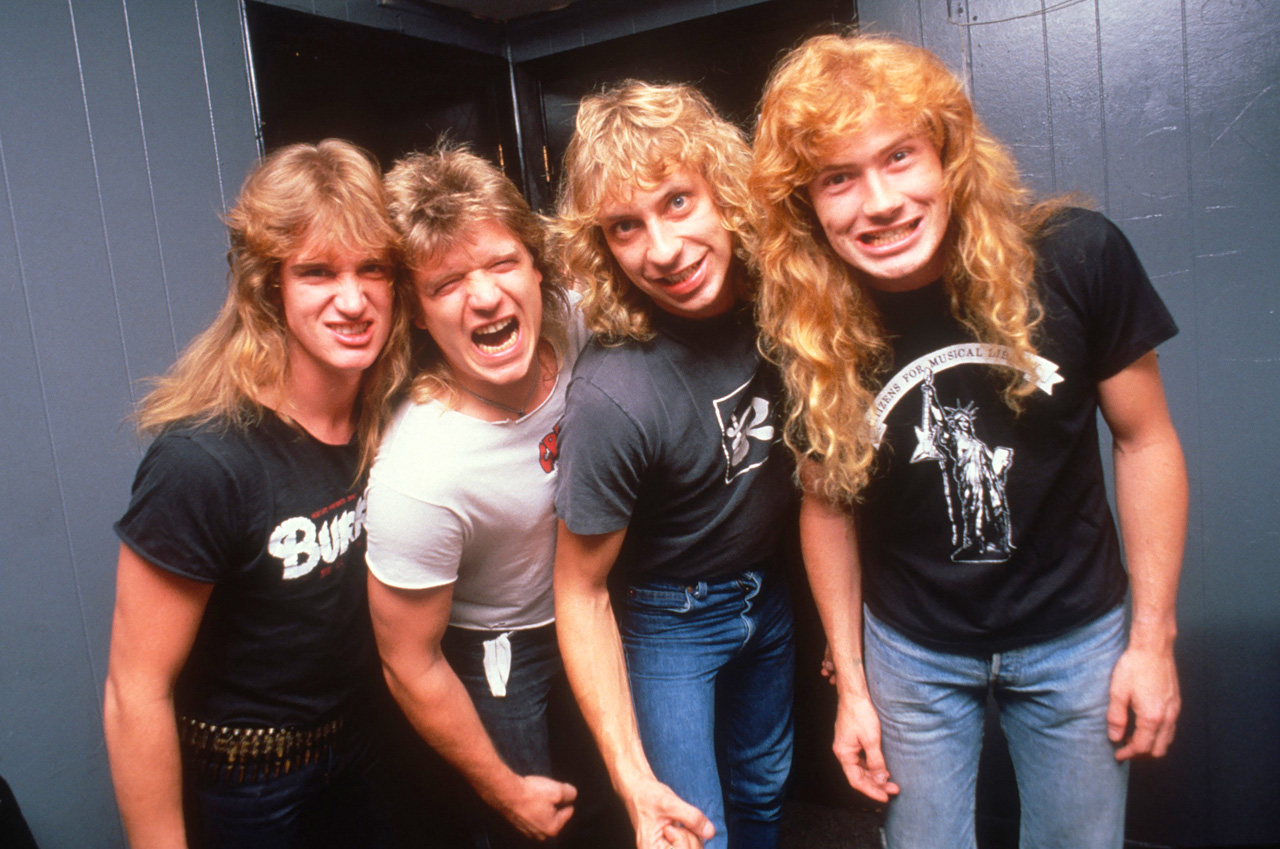
The venerable bluesman wasn’t the only one impressed by the band. In the wake of Metallica’s success, the record industry had turned its gaze towards the thrash scene, and the major labels were circling any band wearing white high-top sneakers and black T-shirts with the sleeves cut off. Even though Peace Sells had yet to be released, Megadeth were being courted by more than one label. Michael Alago, the man who had set off this whole avalanche by signing Metallica to Elektra, was first in the queue.
“He flew us to New York, put us up at the Omni Hotel by Central Park. Finally we were feeling like: ‘Oh my God, there’s food, we’re not completely broke,’” says Ellefson.
Alago’s interest sparked off a bidding war, but in the end it was Capitol, not Elektra, who bought out Megadeth’s contract from Combat. The clout of a major label meant that their album would automatically reach more people than it would if the band remained in the thrash metal ghetto. These four destitute junkies were going up in the world.
“We still had our bleak living situation back in Hollywood,” says Mustaine, “but our new manager fronted us a little bit of money so we could pay our bills, get on our own two feet, stop living like homeless heroin addicts.”
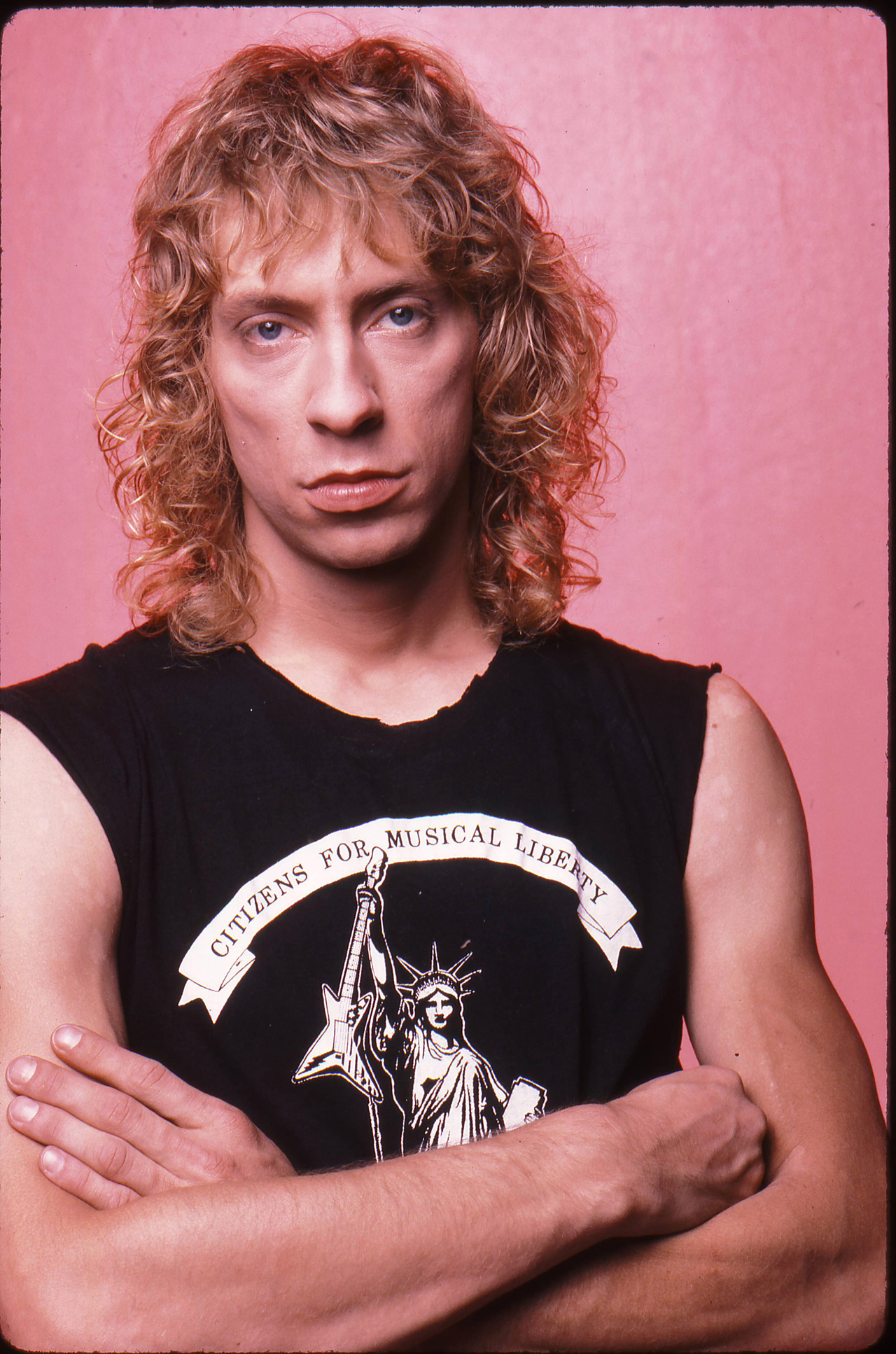
Dave Ellefson can remember vividly the first time he played the finished version of Peace Sells… But Who’s Buying? The band had been given $10,000 by their management to get their lives together, and Ellefson, Mustaine and Poland had moved into a rented three-bedroom apartment in the Los Angeles suburb of Echo Park. Capitol had brought in producer Paul Lani to remix the album and give it a slicker sound that would be more acceptable to the mainstream. But that wasn’t the first thing on Ellefson’s mind.
“We had a stereo, and I’ll never forget me and Dave and Chris putting the Peace Sells vinyl on the stereo and watching that Capitol logo going round and round and round, just like it did on those Beatles records,” Ellefson recalls. “That was a life-changing moment right there.”
Peace Sells… But Who’s Buying? was released on September 19, 1986, six months after Metallica’s Master Of Puppets and a month before Slayer’s Reign In Blood. Thrash metal was undergoing a transformation. No longer was it seen as heavy metal’s feral offspring, but as a legitimate musical movement, a changing of the guard.
This new‑found respect was reflected in the media’s reaction. Where Megadeth had previously been confined to the underground metal press, they were now being written about by the likes of the NME and Rolling Stone. “I remember Rolling Stone saying I was the new Stevie Ray Vaughan,” says Mustaine. “I was like, ‘Get the fuck out.’ Cos I love Stevie Ray Vaughan.”
Like punk before it, thrash metal was a break with the past. Metal’s old guard didn’t understand its velocity and realism, its lack of dragons and rainbows. Megadeth’s audience wasn’t just the denim and leather crowd, it also pulled in skate punks and surf rats, kids who grew up listening to Black Flag rather than Black Sabbath. Influential skate mags such as Thrasher latched on to the likes of Megadeth, giving them an air of edginess that the previous generation lacked.
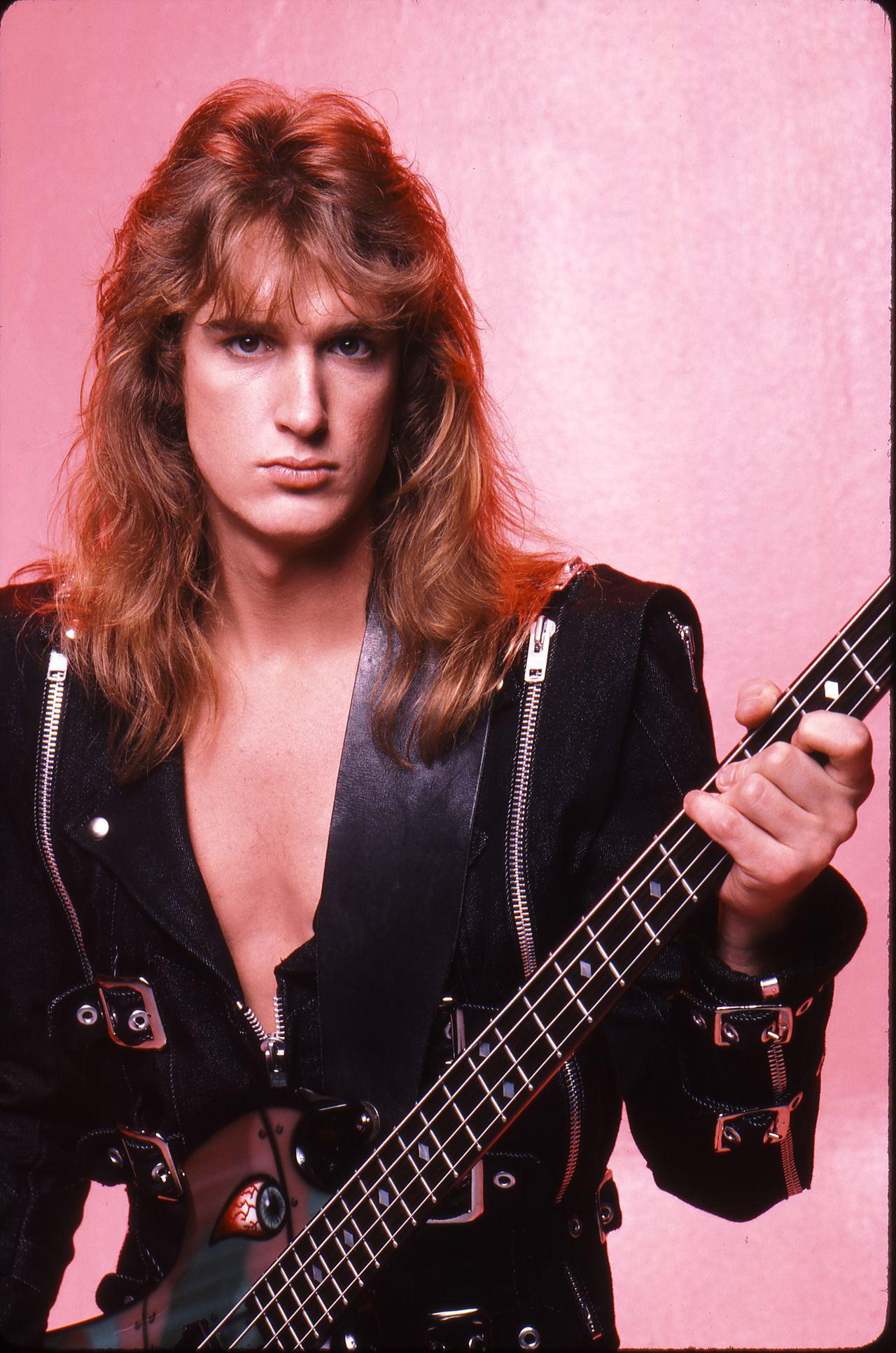
“I lived in Huntington Beach and surfed, and in the beginning that’s where we got the majority of our popularity coming from,” says Mustaine. “Our friends were all beach kids.”
As well as a higher profile, the financial backing of Capitol gave Megadeth the juice to go out on tour with some big-name bands. But their first attempt, a handful of dates down the US west coast with Motörhead, was a disaster.
“It was tumultuous,” says Ellefson. “It was on their Orgasmatron tour. They had these train tracks that Pete Gill, the drummer, would come out to the front of the stage on, then they’d go back. But it meant we had to set our drums up off to the side. So our management and their management basically had a big dick‑swinging contest, and we lost. They pulled us off the tour. It was supposed to be five dates but we only did three.”
More successful was a month-long stint opening for Alice Cooper at the beginning of 1987. “The tour taught me so much about how to be a musician, and how to do your job,” says Mustaine. “Alice is one of those guys who you can really, really look up to. In fact that’s why I ended up asking him to be my godfather.”
Apocryphal stories have suggested that Megadeth – and particularly their singer – were so fucked up that Alice himself staged an intervention. Not true, according to Mustaine.
“No, you’re making a big deal out of nothing,” he says. “He asked me and Ellefson to come in his bus, and he told us: ‘Hey, you keep partying and you’re gonna go this way; you don’t, you’re gonna go that way.’ There was no intervention.”
Either way, Mustaine’s state of mind wasn’t helped by recent events. In December 1986, his former bandmate in Metallica, bassist Cliff Burton, had been killed in a bus crash while on tour in Sweden. Mustaine was devastated. His self-destructive behaviour, already out of control, began to spiral even further downwards.
“I took it badly,” he says. “Very badly. And I was mad because the guys [in Metallica] didn’t let me know. Somebody who worked at the label had to call and tell me. Consequently, that day I wrote the song In My Darkest Hour. A lot of people have misinterpreted that song and think of the lyrics as about Cliff. They’re not. The music I wrote just in sadness, that day I found that out. The lyrics came that day too, but they weren’t necessarily combined.”
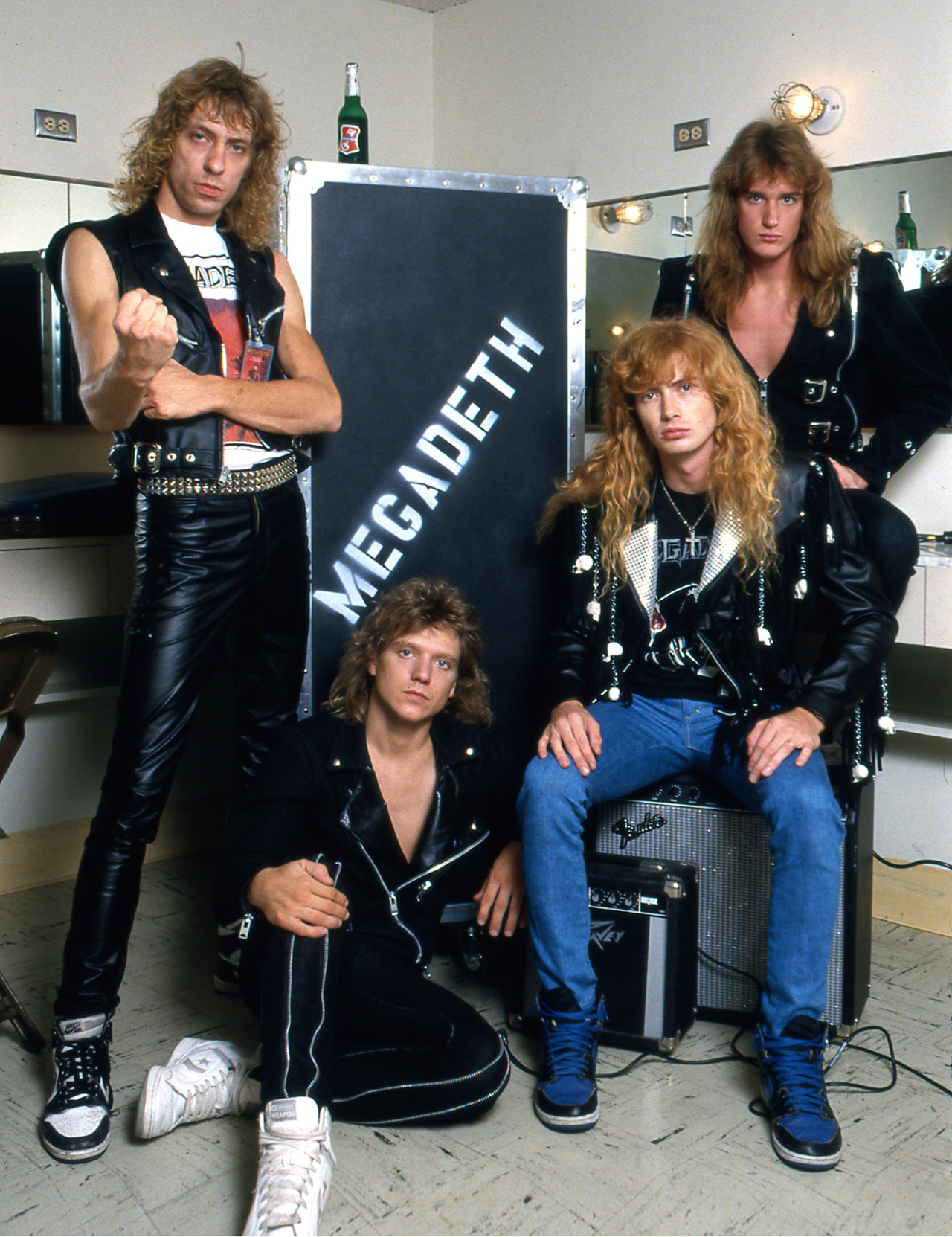
In My Darkest Hour would eventually appear on 1988’s So Far, So Good… So What!, an album that saw Mustaine and Ellefson hitting rock bottom in their personal lives. But even through 1986 and 1987, Megadeth were a band on their own highway to hell.
“There were a lot of very erratic performances,” says Ellefson. “You could tell the ones where we were drinking and the ones where we were on heroin. Because we survived it, we can look back on it with amusement. But when you’re in it, it’s brutal. And it ultimately ripped that line-up apart.”
The Peace Sells tour ended in Hawaii 18 months after it began. Such a long period on the road only worsened the tensions between the Mustaine/Ellefson axis and the increasingly separate Chris Poland/Gar Samuelson. And in that particular civil war there was only ever going to be one winner. After the tour finished, Poland and Samuelson were fired.
“The addictions that were around were absolutely a part of it,” says Ellefson. “It felt weird for me and Dave to go to Gar and Chris and let them go, because it’s kind of like the pot calling the kettle black. Dave and I were certainly deep into it, but we were still able to keep it together and get on tour and play. There were problems with them that were preventing them from doing that.”
After leaving Megadeth, Chris Poland sobered up and joined LA punk band the Circle Jerks before embarking on a solo career. He played guitar on the demos for Megadeth’s 1990 album Rust In Peace and as a hired hand on 2004’s The System Has Failed. But his turbulent relationship with Mustaine has meant that he has never rejoined Megadeth.
Gar Samuelson was less fortunate. The drummer died of liver failure in 1999 at the age of 41. “He was one of those guys that you knew something bad was gonna happen to at some point,” says Mustaine. “You just knew it, because of the way that we lived our life back then.”
“It was heartbreaking, cos we loved Gar,” Ellefson says. “He was just such a sweet guy.”
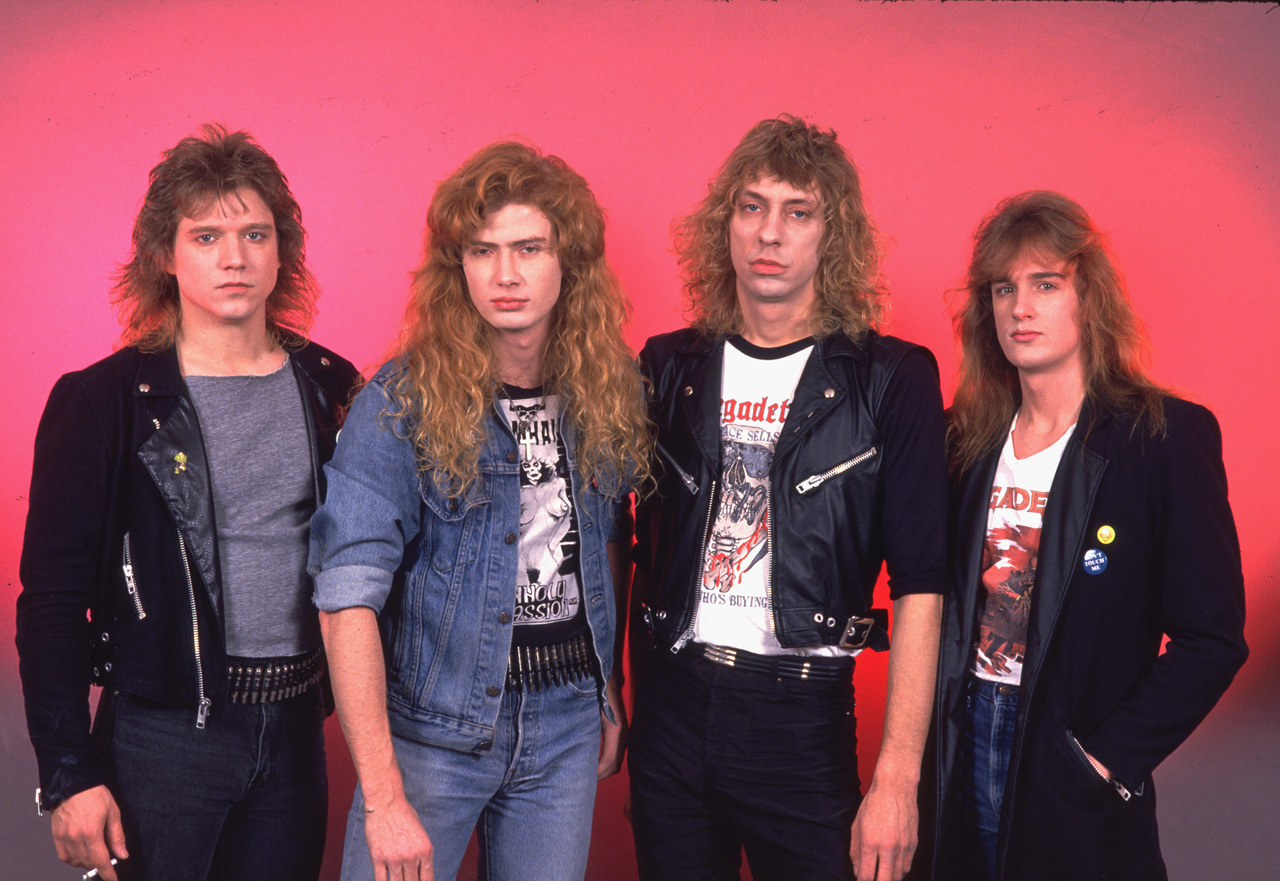
More than 30 years on, Peace Sells… But Who’s Buying? remains one of the benchmark records of the 1980s. Megadeth themselves arguably bettered it with Rust In Peace, an album that benefitted from their newfound sobriety, but even that can’t match the sheer youthful rush of Peace Sells.
“Every once in a while you’ll read something where somebody says: ‘I can’t believe what I was thinking when I wrote that,’” says Mustaine. “That’s the thought that goes through my head when I hear this record. Some of those riffs, it’s like, ‘Where did they come from? They don’t sound like UFO, they don’t sound like Diamond Head, they don’t sound like Priest or Maiden.’”
More significantly, Peace Sells… But Who’s Buying? – along with Metallica’s Master Of Puppets, Slayer’s Reign In Blood and, a year later, Anthrax’s Among The Living – was one corner of the foundations for the Big Four. Thrash metal had grown out of its adolescence and was hurtling full-tilt towards adulthood. The guard had changed, and things would never be the same again.
Beyond The Big Four
Classic albums from thrash metal’s heyday that are by someone other than the ‘usual suspects’.
Exodus - Bonded By Blood (1984)
Arguably the original thrash band (Metallica poached their guitarist Kirk Hammett to replace Dave Mustaine), Exodus are also the most undeservedly overlooked. Their debut album remains a lesson in unhinged, wild‑eyed brutality.
Kreator - Pleasure To Kill (1986)
Proving that Europe could do thrash just as well as America, Germany’s Kreator took the genre’s blueprint and intensified it even further. The surgical riffs and barked vocals of their second album made many of their American counterparts sound like Journey.
Testament - The Legacy (1987)
Bay Area mainstays Testament may have been late to the thrash metal party, but their debut album stands among the most influential records of the period. If the membership of the Big Four had been expanded to five, they would have been a shoo-in.
Celtic Frost - Into The Pandemonium (1987)
Tom G Warrior’s Swiss mavericks were the chief – and most likely only – exponents of what was dubbed ‘avant-garde thrash’. Classical music, funereal dirges and even lo-fi hip-hop were folded into their sound. The resultant album sounded like nothing else before or since.
Death Angel - The Ultra-Violence (1987)
Death Angel were formed by three cousins of Filipino descent. They were youthful even by thrash standards, and their stellar debut album marked them out as future greats. However, an oversaturated market and growing thrash fatigue meant they were confined to the lower divisions.
Megadeth’s Dave Mustaine: The 10 Albums That Changed My Life
